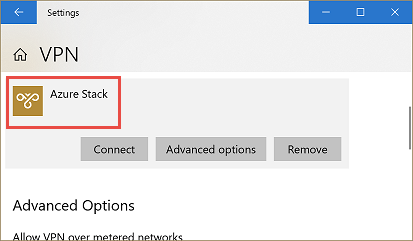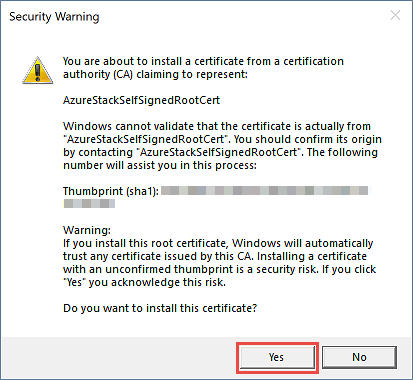Connect to the ASDK
To manage resources, you must first connect to the Azure Stack Development Kit (ASDK). In this article, we describe the steps that you take to connect to the ASDK by using the following connection options:
- Remote Desktop Connection (RDP): When you connect by using Remote Desktop Connection, a single user can quickly connect to the ASDK.
- Virtual Private Network (VPN): When you connect by using a VPN, multiple users can concurrently connect to the Azure Stack portals from clients outside the Azure Stack infrastructure. A VPN connection requires some setup.
Connect to Azure Stack using RDP
A single concurrent user can manage resources in the Azure Stack administrator portal or the user portal through Remote Desktop Connection directly from the ASDK host computer.
Tip
This option also enables you to use RDP again while signed into the ASDK host computer to sign in to virtual machines (VMs) created on the ASDK host computer.
Open Remote Desktop Connection (mstc.exe) and connect to the ASDK host computer IP address. Make sure you use an account authorized to sign in remotely to the ASDK host computer. By default, AzureStack\AzureStackAdmin has permissions to remote in to the ASDK host computer.
On the ASDK host computer, open Server Manager (ServerManager.exe). Select Local Server, turn off IE Enhanced Security Configuration, and close Server Manager.
Sign in to the administrator portal as AzureStack\CloudAdmin or use other Azure Stack Operator credentials. The ASDK administrator portal address is
https://adminportal.local.azurestack.external.Sign in to the user portal as AzureStack\CloudAdmin or use other Azure Stack user credentials. The ASDK user portal address is
https://portal.local.azurestack.external.
Note
For more info on when to use which account, see ASDK admin basics.
Connect to Azure Stack using VPN
You can establish a split tunnel VPN connection to an ASDK host computer to access the Azure Stack portals and locally installed tools like Visual Studio and PowerShell. Using VPN connections, multiple users can connect at the same time to Azure Stack resources hosted by the ASDK.
VPN connectivity is supported for both Microsoft Entra ID and Active Directory Federation Services (AD FS) deployments.
Note
A VPN connection does not provide connectivity to Azure Stack VMs. You won't be able to RDP into Azure Stack VMs while connected via VPN.
Prerequisites
Before setting up a VPN connection to the ASDK, ensure you've met the following prerequisites:
- Install Azure Stack-compatible Azure PowerShell on your local computer.
- Download the tools required to work with Azure Stack.
Set up VPN connectivity
To create a VPN connection to the ASDK, open PowerShell as an admin on your local Windows-based computer. Then, run the following script (update the IP address and password values for your environment).
# Change directories to the default Azure Stack tools directory
cd C:\AzureStack-Tools-az
# Configure Windows Remote Management (WinRM), if it's not already configured.
winrm quickconfig
Set-ExecutionPolicy RemoteSigned
# Import the Connect module.
Import-Module .\Connect\AzureStack.Connect.psm1
# Add the ASDK host computer's IP address as the ASDK certificate authority (CA) to the list of trusted hosts. Make sure you update the IP address and password values for your environment.
$hostIP = "<Azure Stack Hub host IP address>"
$Password = ConvertTo-SecureString `
"<operator's password provided when deploying Azure Stack>" `
-AsPlainText `
-Force
Set-Item wsman:\localhost\Client\TrustedHosts `
-Value $hostIP `
-Concatenate
# Create a VPN connection entry for the local user.
Add-AzsVpnConnection `
-ServerAddress $hostIP `
-Password $Password
If the setup succeeds, Azure Stack appears in your list of VPN connections:

Connect to Azure Stack
Connect to the Azure Stack instance by using one of the following methods:
Use the
Connect-AzsVpncommand:Connect-AzsVpn ` -Password $PasswordOn your local computer, select Network Settings > VPN > Azure Stack > connect. At the sign-in prompt, enter the user name (AzureStack\AzureStackAdmin) and your password.
The first time you connect, you'll be prompted to install the Azure Stack root certificate from AzureStackCertificateAuthority in your local computer's certificate store. This step adds the ASDK certificate authority (CA) to the list of trusted hosts. Click Yes to install the certificate.

Important
The prompt might be hidden by the PowerShell window or other apps.
Test VPN connectivity
To test the portal connection, open a browser, and then go to either the user portal at https://portal.local.azurestack.external/ or the administrator portal https://adminportal.local.azurestack.external/.
Sign in with the appropriate subscription credentials to create and manage resources.
Next steps
Feedback
Coming soon: Throughout 2024 we will be phasing out GitHub Issues as the feedback mechanism for content and replacing it with a new feedback system. For more information see: https://aka.ms/ContentUserFeedback.
Submit and view feedback for